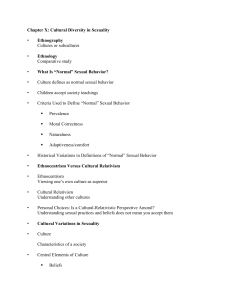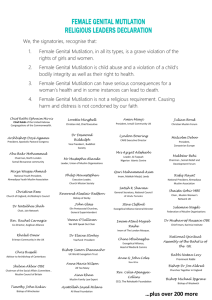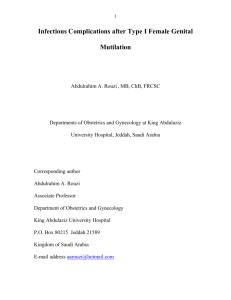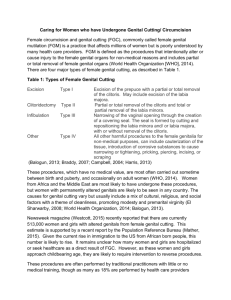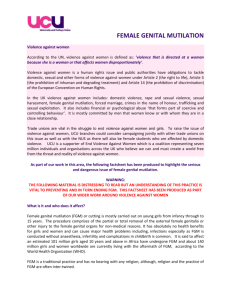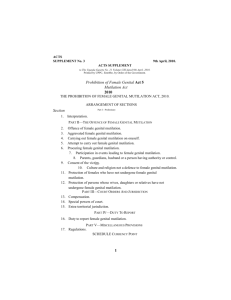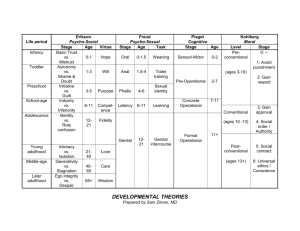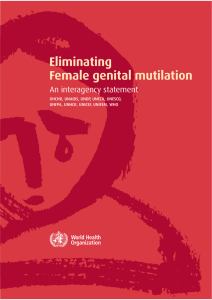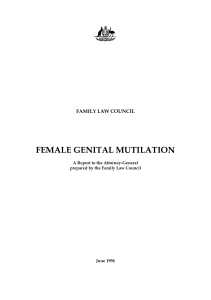Female genital mutilation
advertisement
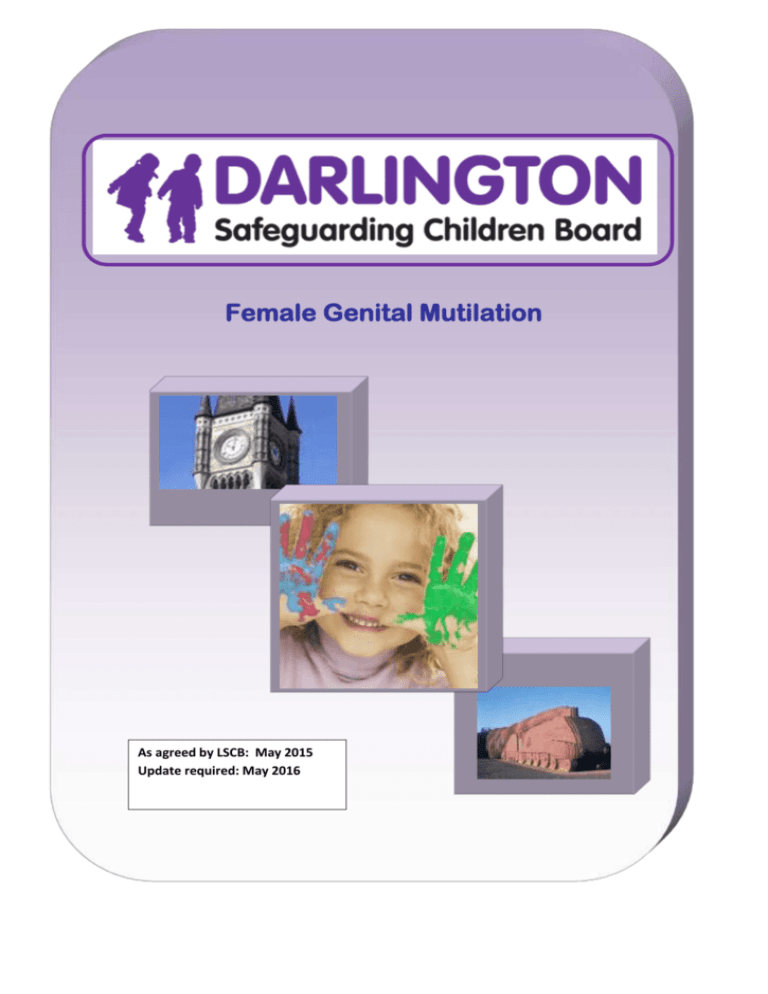
Female Genital Mutilation As agreed by LSCB: May 2015 Update required: May 2016 FEMALE GENITAL MUTILIATION In the UK Female Genital Mutilation (FGM) is now illegal and is prohibited by the Female Genital Mutilation Act 2003. This also includes any female genital mutilation that takes place outside of the UK and covers any adult who takes a child out of the country for that purpose. Female genital mutilation is commonly practised in many African countries and in parts of the Middle and Far East, but it has also been found more recently in Western Europe and other developed countries, including in the UK, usually amongst immigrant and refugee communities. Female genital mutilation causes real physical and emotional harm to children who are not usually in a position to resist or to give informed consent. However families who practice female genital mutilation believe that it maintains the family honour and is part of their customs and traditions. They consider that it encourages hygiene and cleanliness and preserves virginity and chastity, which are all seen as essential for marriage. Some communities believe that it is a religious requirement, and for many families it promotes a sense of belonging and carries with it the fear of social exclusion for those who do not take part. Female genital mutilation is also known as female circumcision and takes three main forms: Circumcision: (Sunna) This is the least severe form of female genital mutilation, known as Sunna, which means ’tradition’ in Arabic and involves the removal of the hood of the clitoris preserving the clitoris itself. Excision: (Clitoridectomy) This involves the partial or total removal of the clitoris together with parts of the whole of the labia minora (the small lips which cover and protect the opening of the vagina and the urinary opening). Large scar tissue remains after healing. Infibulation: (also called Pharaonic Circumcision) This is the most severe form of female genital mutilation where the clitoris, the whole of the labia minora and the internal parts of the labia majora (the outer lips of the genitals, which lubricate the inside of the skin folds to prevent soreness) are removed. The two sides of the vulva are then sown together with silk, catgut sutures, or thorns leaving only a very small opening to allow for the passage of urine and menstrual flow. Unclassified This includes all other operations on the female genitalia including pricking, piercing, and stretching of the vulva region, incision of the clitoris and/ or labia, cauterisation by burning the clitoris and surrounding tissues, incisions to the vaginal wall, scraping (anqurya cuts) or cutting (gishiri cuts) of the vagina and surrounding tissues. The impact of female genital mutilation Some female children are particularly vulnerable to the risk of female genital mutilation. The procedure is usually performed on prepubescent girls aged between four and 13, but in some cases it is carried out on newborn infants or on young women before marriage or pregnancy. A number of girls die as a result of blood loss or infection. Female genital mutilation can lead to complications and emotional consequences which affect the child’s physical and psychological health, their later sexual relationships and childbirth. It can sometimes cause immediate fatal haemorrhaging. Short-term health implications include: a) severe pain and shock and sometimes death b) infections c) urinary retention d) injury or damage to nearby tissues or to other organs as a result of restraint Long term health implications include: a) damage to the reproductive system, including infertility and complications in pregnancy and childbirth b) uterine, vaginal and pelvic infections c) psychological damage; including mental health disorders such as depression and anxiety and psychosexual problems including sexual dysfunction or frigidity d) difficulties in menstruation and passing urine e) increased risk of HIV transmission Signals and indicators Some professionals are in a good position to detect the risk of Female Genital Mutilation, particularly staff and teachers in primary schools and school nurses and other professionals in health care settings. What to look for There are a number of indications that female genital mutilation may take place: The family comes from a community that is known to practice female genital mutilation such as Somalian, Sudanese and other sub-Saharan countries. A child may talk about a long holiday to her country of origin and may confide to a teacher, school nurse or welfare officer, teacher’s aide or adult helper that she is to have a ‘special procedure’ or going to attend a special occasion. A child may talk about female genital mutilation or circumcision in conversation. A parent may state that they or a relative are to take the child out of the country for a prolonged period of time. Indications that female genital mutilation may have already taken place include: A child may spend long periods of time away from the class during the school day, with bladder or menstrual problems. There may be prolonged absences from school because of bladder or menstrual problems. A long absence from school with noticeable behaviour changes on the girl’s return could also be an indication that a girl has undergone female genital mutilation. A referral to the school nurse may reveal the physical signs that suggest female genital mutilation has taken place. What to do Any decisions or plans for a child who has been or may be subject to female genital mutilation should always be based on a thorough assessment that is aware of, and sensitive to, the issues of race, culture, gender, religion and sexuality. Every attempt should be made to work with parents on a voluntary basis to help them understand the harmful effects of female genital mutilation and that the practice is illegal in this country. Parents do not usually intend it as an act of abuse, but genuinely believe that it is in the girl’s best interests to conform with their customs and beliefs. They should be encouraged to stop the abuse and offered advice and information in whatever way is helpful for them. At this stage it is often useful to involve members of the family’s own community who understand the reasons behind the enquiries. Where there are concerns that a child is at risk of, or has already undergone Female Genital Mutilation, this will normally be dealt with as a child protection referral under Section 47 of the Children Act (1989). The police and relevant health and legal professionals should be involved. The police will also have to consider whether any criminal offence has taken place. If the family’s first language is not English it can be helpful to use a female interpreter who is not a family relation when carrying out interviews with the family. Even though a child has been identified as at risk of significant harm, it may not be helpful to consider removing the child from an otherwise loving family environment. The main aim is to prevent the child undergoing any form of female genital mutilation, rather than removal from the family. If it is not possible to reach an agreement with the parents, the priority is then to protect the child using the minimum of legal action needed to keep the child safe. But if the child is in immediate danger of mutilation, or is about to be sent out of the country for that purpose, and her parents are determined to go ahead, the next step is to seek a Prohibited Steps Order, with or without a Supervision Order or in extreme circumstances, an Emergency Protection Order. If a child has already undergone female genital mutilation The circumstances and the implications for the child will need to be assessed. Again this will normally involve the police and other professionals. The police will also have to consider whether any criminal offence has taken place. It would be helpful, with the child and parent’s consent, to carry out a medical examination of the child. There may be a risk to other female children in the family and this will need to be assessed as well. A child protection conference may be needed if there are unresolved child protection issues, once the initial investigation and assessment have been completed. If a woman has undergone female genital mutilation Sometimes a woman who has already undergone female genital mutilation will come to professional attention. Talking about the experience with her will provide an opportunity to assess her needs and the implications for any female children she may have, or any younger siblings or extended family who might be at risk of female genital mutilation. Female genital mutilation is an illegal, painful and unnecessary procedure that brings with it many health risks and long term consequences for the child. It continues to be practiced within a number of communities and will require a multi faceted approach to deal with it which includes understanding, education and sensitive practice.
